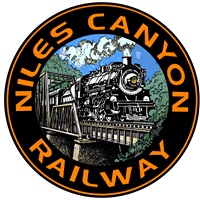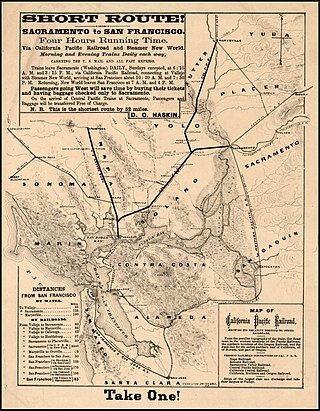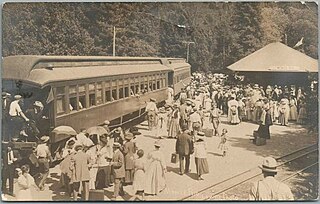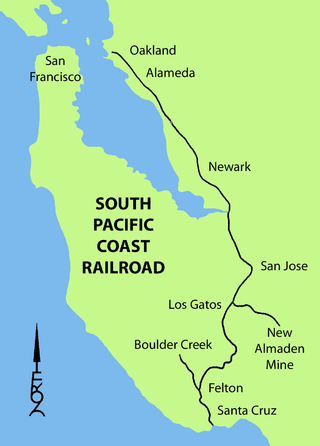
Napa County is a county north of San Pablo Bay located in the northern portion of the U.S. state of California. As of the 2020 census, the population was 138,019. The county seat is the City of Napa. Napa County was one of the original counties of California, created in 1850 at the time of statehood. Parts of the county's territory were given to Lake County in 1861.

The Key System was a privately owned company that provided mass transit in the cities of Oakland, Berkeley, Alameda, Emeryville, Piedmont, San Leandro, Richmond, Albany, and El Cerrito in the eastern San Francisco Bay Area from 1903 until 1960, when it was sold to a newly formed public agency, AC Transit. The Key System consisted of local streetcar and bus lines in the East Bay, and commuter rail and bus lines connecting the East Bay to San Francisco by a ferry pier on San Francisco Bay, later via the lower deck of the Bay Bridge. At its height during the 1940s, the Key System had over 66 miles (106 km) of track. The local streetcars were discontinued in 1948 and the commuter trains to San Francisco were discontinued in 1958. The Key System's territory is today served by BART and AC Transit bus service.

State Route 29 is a state highway in the U.S. state of California that travels from Interstate 80 in Vallejo north to State Route 20 in Upper Lake. It serves as the primary road through the Napa Valley, providing access to the Lake County region to the north and the rest of the San Francisco Bay Area to the south.

The Niles Canyon Railway (NCRy) is a heritage railway running on the first transcontinental railroad alignment through Niles Canyon, between Sunol and the Niles district of Fremont in the East Bay of the San Francisco Bay Area, in California, United States. The railway is listed on the National Register of Historic Places as the Niles Canyon Transcontinental Railroad Historic District. The railroad is operated and maintained by the Pacific Locomotive Association which preserves, restores and operates historic railroad equipment. The NCRy features public excursions with both steam and diesel locomotives along a well-preserved portion of the first transcontinental railroad.

The California Pacific Railroad Company was incorporated in 1865 at San Francisco, California as the California Pacific Rail Road Company. It was renamed the California Pacific Railroad Extension Company in the spring of 1869, then renamed the California Pacific Railroad later that same year. Its main line from Vallejo to Sacramento was completed six months prior to the May 1869 golden spike ceremony of the Central Pacific/Union Pacific Transcontinental Railway.

The Napa Valley Wine Train is a privately operated excursion train that runs between Napa and St. Helena, California. Much of the rail line parallels State Route 29 after leaving the City of Napa and passes the towns of Yountville, Rutherford and Oakville. The route passes by many of the region's vineyards and wineries located in Napa County. The Wine Train is operated by the Napa Valley Railroad.

The East Bay Electric Lines were a unit of the Southern Pacific Railroad that operated electric interurban-type trains in the East Bay region of the San Francisco Bay Area. Beginning in 1862, the SP and its predecessors operated local steam-drawn ferry-train passenger service in the East Bay on an expanding system of lines, but in 1902 the Key System started a competing system of electric lines and ferries. The SP then drew up plans to expand and electrify its system of lines and this new service began in 1911. The trains served the cities of Berkeley, Albany, Emeryville, Oakland, Alameda, and San Leandro transporting commuters to and from the large Oakland Pier and SP Alameda Pier. A fleet of ferry boats ran between these piers and the docks of the Ferry Building on the San Francisco Embarcadero.

The Sacramento Northern Railway was a 183-mile (295 km) electric interurban railway that connected Chico in northern California with Oakland via the state capital, Sacramento. In its operation it ran directly on the streets of Oakland, Sacramento, Yuba City, Chico, and Woodland. This involved multiple car trains making sharp turns at street corners and obeying traffic signals. Once in open country, SN's passenger trains ran at fairly fast speeds. With its shorter route and lower fares, the SN provided strong competition to the Southern Pacific and Western Pacific Railroad for passenger business and freight business between those two cities. North of Sacramento, both passenger and freight business was less due to the small town agricultural nature of the region and due to competition from the paralleling Southern Pacific Railroad.

The North Pacific Coast Railroad (NPC) was a common carrier 3 ft (914 mm) narrow-gauge steam railroad begun in 1874 and sold in 1902 to new owners who renamed it the North Shore Railroad (California) (NSR) and rebuilt the southern section into a standard-gauge electric railway.

San Francisco Bay in California has been served by ferries of all types for over 150 years. John Reed established a sailboat ferry service in 1826. Although the construction of the Golden Gate Bridge and the San Francisco–Oakland Bay Bridge led to the decline in the importance of most ferries, some are still in use today for both commuters and tourists.

The South Pacific Coast Railroad (SPC) was a 3 ft narrow gauge steam railroad running between Santa Cruz, California, and Alameda, with a ferry connection in Alameda to San Francisco. The railroad was created as the Santa Clara Valley Railroad, founded by local strawberry growers as a way to get their crops to market in San Francisco and provide an alternative to the Southern Pacific Railroad. In 1876, James Graham Fair, a Comstock Lode silver baron, bought the line and extended it into the Santa Cruz Mountains to capture the significant lumber traffic coming out of the redwood forests. The narrow-gauge line was originally laid with 52-pound-per-yard (26 kg/m) rail on 8-foot (2.44 m) redwood ties; and was later acquired by the Southern Pacific and converted to 4 ft 8+1⁄2 instandard gauge.

Martinez station is an Amtrak passenger train station in Martinez, California, United States. Located at the west end of downtown Martinez, the station has one side platform and one island platform, which serve three of the four tracks of the Union Pacific Railroad Martinez Subdivision. It is served by the daily California Zephyr and Coast Starlight long-distance trains, five daily round trips of the San Joaquin corridor service, and fifteen daily round trips of the Capitol Corridor service. Martinez is also served by Amtrak Thruway buses plus County Connection, Tri-Delta Transit, and WestCAT local buses.

VINE Transit is a public transportation service in Napa County, California, United States; it is managed under the Napa Valley Transportation Authority and operated by Transdev. The system offers extensive service throughout the county along with providing connections to other public transportation systems in adjacent counties. In 2023, the system had a ridership of 498,600, or about 1,900 per weekday as of the third quarter of 2024.
The Sacramento Valley Electric Railroad, later known as the Dixon Branch, was a short-lived electric interurban railway in the U.S. state of California. It began operation on October 10, 1914, and ran for 11.8 miles (19.0 km) between Dixon and Rio Junction ; it ran from a point on the main line known as Olcott, that was located in Solano County between Sacramento and Rio Vista Junction. The line was run by the Oakland, Antioch, & Eastern Railway, and was abandoned on August 9, 1917, after decreasing revenue.
This article lists the railroads and a timeline of railroad history in Solano County, California.
The San Francisco and Oakland Railroad (SF&O) was built in 1862 to provide ferry-train service from a San Francisco ferry terminal connecting with railroad service through Oakland to San Antonio. In 1868 Central Pacific Railroad decided that Oakland would be the west coast terminus of the First transcontinental railroad and bought SF&O. Beginning November 8, 1869, part of the SF&O line served as the westernmost portion of the transcontinental railroad. It subsequently was absorbed into the Southern Pacific Railroad (SP). The track in Oakland was electrified in 1911 and extended across the San Francisco-Oakland Bay Bridge in 1939. Service was abandoned in 1941.
The Western Pacific Railroad (1862–1870) was formed in 1862 to build a railroad from Sacramento, California, to the San Francisco Bay, the westernmost portion of the First transcontinental railroad. After the completion of the railroad from Sacramento to Alameda Terminal on September 6, 1869, and then the Oakland Pier on November 8, 1869, which was the Pacific coast terminus of the transcontinental railroad, the Western Pacific Railroad was absorbed in 1870 into the Central Pacific Railroad.
The Vallejo and Northern Railroad was a proposed 58.15-mile (93.58 km) interurban railway line between Vallejo and Woodland, California. The company was incorporated on November 9, 1906, promoted by the same person who put forward the Dixon Branch. Terminal sites were purchased in Fairfield, Suisun, Vacaville, and Vallejo, California. Additionally, the railroad also began planning an extension from Woodland to Sacramento, going on to acquire franchise rights for running on Sacramento streets and purchasing property in Woodland. Despite the swift property acquisition, construction had not commenced, reportedly a result of the Panic of 1907. The company was merged into the Sacramento Northern Railway predecessor Northern Electric Railway in 1909 after Northern Electric floated $10 million worth of bonds in Amsterdam. A single tram lettered Vallejo & Northern # 1 operated in downtown Sacramento from November 15, 1911 until 1914. Construction of what would become the Sacramento Northern Vaca Valley Line began in 1913; and line opened for service on May 16, 1914. Northern Electric combination cars numbered 103, 104, and 22 offered passenger service over this isolated branch until passenger service was abandoned in 1926. Motor #701 pulled carloads of freight transferred from barges and shallow-draft steamboats at Suisun. The line was connected to Sacramento Northern's main line via a new branch between Vacaville and Creed in 1930. Western Pacific Railroad proposed extending the Willotta branch of their Sacramento Northern subsidiary through Jamison Canyon to connect with the Petaluma and Santa Rosa Railroad (P&SR) as late as 1932, but the Great Depression and Northwestern Pacific Railroad purchase of the P&SR prevented such expansion. The connecting line through Cordero was relocated during construction of Travis Air Force Base in 1942, and diesel locomotives replaced electric operation in 1947.

The Northwestern Pacific Railroad operated a network of electric interurban lines in Marin County, California from 1903 to 1941. The lines ran to Sausalito at the southern tip of the county, where connecting ferries ran to San Francisco. Trains consisted of electric multiple units powered by third rail electrification. The lines were the first third-rail electrification in California, and the first major railroad to use alternating current signals.















